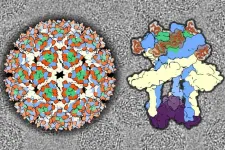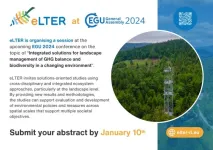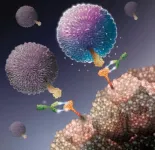(Press-News.org) Researchers at the Georgia Institute of Technology have created the world’s first functional semiconductor made from graphene, a single sheet of carbon atoms held together by the strongest bonds known. Semiconductors, which are materials that conduct electricity under specific conditions, are foundational components of electronic devices. The team’s breakthrough throws open the door to a new way of doing electronics.
Their discovery comes at a time when silicon, the material from which nearly all modern electronics are made, is reaching its limit in the face of increasingly faster computing and smaller electronic devices. Walter de Heer, Regents’ Professor of physics at Georgia Tech, led a team of researchers based in Atlanta, Georgia, and Tianjin, China, to produce a graphene semiconductor that is compatible with conventional microelectronics processing methods — a necessity for any viable alternative to silicon.
In this latest research, published in Nature, de Heer and his team overcame the paramount hurdle that has been plaguing graphene research for decades, and the reason why many thought graphene electronics would never work. Known as the “band gap,” it is a crucial electronic property that allows semiconductors to switch on and off. Graphene didn’t have a band gap — until now.
“We now have an extremely robust graphene semiconductor with 10 times the mobility of silicon, and which also has unique properties not available in silicon,” de Heer said. “But the story of our work for the past 10 years has been, ‘Can we get this material to be good enough to work?’”
A New Type of Semiconductor
De Heer started to explore carbon-based materials as potential semiconductors early in his career, and then made the switch to exploring two-dimensional graphene in 2001. He knew then that graphene had potential for electronics.
“We were motivated by the hope of introducing three special properties of graphene into electronics,” he said. “It’s an extremely robust material, one that can handle very large currents, and can do so without heating up and falling apart.”
De Heer achieved a breakthrough when he and his team figured out how to grow graphene on silicon carbide wafers using special furnaces. They produced epitaxial graphene, which is a single layer that grows on a crystal face of the silicon carbide. The team found that when it was made properly, the epitaxial graphene chemically bonded to the silicon carbide and started to show semiconducting properties.
Over the next decade, they persisted in perfecting the material at Georgia Tech and later in collaboration with colleagues at the Tianjin International Center for Nanoparticles and Nanosystems at Tianjin University in China. De Heer founded the center in 2014 with Lei Ma, the center’s director and a co-author of the paper.
How They Did It
In its natural form, graphene is neither a semiconductor nor a metal, but a semimetal. A band gap is a material that can be turned on and off when an electric field is applied to it, which is how all transistors and silicon electronics work. The major question in graphene electronics research was how to switch it on and off so it can work like silicon.
But to make a functional transistor, a semiconducting material must be greatly manipulated, which can damage its properties. To prove that their platform could function as a viable semiconductor, the team needed to measure its electronic properties without damaging it.
They put atoms on the graphene that “donate” electrons to the system — a technique called doping, used to see whether the material was a good conductor. It worked without damaging the material or its properties.
The team’s measurements showed that their graphene semiconductor has 10 times greater mobility than silicon. In other words, the electrons move with very low resistance, which, in electronics, translates to faster computing. “It’s like driving on a gravel road versus driving on a freeway,” de Heer said. “It’s more efficient, it doesn’t heat up as much, and it allows for higher speeds so that the electrons can move faster.”
The team’s product is currently the only two-dimensional semiconductor that has all the necessary properties to be used in nanoelectronics, and its electrical properties are far superior to any other 2D semiconductors currently in development.
“A long-standing problem in graphene electronics is that graphene didn’t have the right band gap and couldn’t switch on and off at the correct ratio,” said Ma. “Over the years, many have tried to address this with a variety of methods. Our technology achieves the band gap, and is a crucial step in realizing graphene-based electronics.”
Moving Forward
Epitaxial graphene could cause a paradigm shift in the field of electronics and allow for completely new technologies that take advantage of its unique properties. The material allows the quantum mechanical wave properties of electrons to be utilized, which is a requirement for quantum computing.
“Our motivation for doing graphene electronics has been there for a long time, and the rest was just making it happen,” de Heer said. “We had to learn how to treat the material, how to make it better and better, and finally how to measure the properties. That took a very, very long time.”
According to de Heer, it is not unusual to see yet another generation of electronics on its way. Before silicon, there were vacuum tubes, and before that, there were wires and telegraphs. Silicon is one of many steps in the history of electronics, and the next step could be graphene.
“To me, this is like a Wright brothers moment,” de Heer said. “They built a plane that could fly 300 feet through the air. But the skeptics asked why the world would need flight when it already had fast trains and boats. But they persisted, and it was the beginning of a technology that can take people across oceans.”
Citation: Zhao, J. et al. Ultrahigh-mobility semiconducting epitaxial graphene on silicon carbide. Nature (2024).
DOI: https://doi.org/10.1038/s41586-023-06811-0
Writer: Catherine Barzler
Video and Photography: Chris McKenney
#####
The Georgia Institute of Technology, or Georgia Tech, is one of the top public research universities in the U.S., developing leaders who advance technology and improve the human condition. The Institute offers business, computing, design, engineering, liberal arts, and sciences degrees. Its more than 45,000 undergraduate and graduate students, representing 50 states and more than 148 countries, study at the main campus in Atlanta, at campuses in France and China, and through distance and online learning. As a leading technological university, Georgia Tech is an engine of economic development for Georgia, the Southeast, and the nation, conducting more than $1 billion in research annually for government, industry, and society.
END
Researchers create first functional semiconductor made from graphene
The technology could allow for smaller and faster devices and may have applications for quantum computing
2024-01-03
ELSE PRESS RELEASES FROM THIS DATE:
Study reveals clues to how Eastern equine encephalitis virus invades brain cells
2024-01-03
An atomic-level investigation of how Eastern equine encephalitis virus binds to a key receptor and gets inside of cells also has enabled the discovery of a decoy molecule that protects against the potentially deadly brain infection, in mice.
The study, from researchers at Washington University School of Medicine in St. Louis, is published Jan. 3 in the journal Cell. By advancing understanding of the complex molecular interactions between viral proteins and their receptors on animal cells, the findings lay a foundation for treatments and vaccines ...
Unraveling the mysteries of the Mongolian Arc: exploring a monumental 405-kilometer wall system in Eastern Mongolia
2024-01-03
New study sheds light on the previously overlooked Mongolian Arc—a monumental wall system in eastern Mongolia spanning 405 kilometers. This discovery not only reveals the significance of this ancient architectural marvel but also prompts crucial questions about the motives, functionality, and broader implications of such colossal constructions. Their findings contribute to a larger multidisciplinary project exploring historical wall systems and their socio-political, economic, and environmental impacts, marking a pivotal milestone in understanding ancient civilizations and their enduring legacies.
[Jerusalem, ...
Call for EGU24 General Assembly Abstracts
2024-01-03
The General Assembly 2024 of the European Geosciences Union (EGU) will be held at the Austria Center Vienna (ACV) in Vienna, Austria and online, from 14–19 April 2024. eLTER will organise the following session:
BG8.14: Integrated solutions for landscape management of GHG balance and biodiversity in a changing environment
Convener: Syed Ashraful Alam, Katri Rankinen, Thomas Dirnböck, Harry Vereecken, Olga Vindušková
The session is co-sponsored by eLTER.
The abstract submission deadline is Wednesday, 10 January 2024, 13:00 CET.
Society is placing increasing and potentially competing demands on our environment. ...
Unlocking sustainable water treatment: the potential of piezoelectric-activated persulfate
2024-01-03
As cities grow bigger and faster, water pollution is becoming a serious problem. We need good ways to clean the water. Traditional cleaning methods, Persulfate (PS)- Advanced Oxidation Processes (AOPs), are good at treating the bad stuff in the water, but they require a lot of energy and chemicals, like special light and metals ions. This is costly and environmentally harmful. It's urgent to find better and more eco-friendly ways to clean it.
In a recent study published in Volume 18 of the journal Environmental Science and Ecotechnology, scientists ...
On-demand conformation of an artificial cytoskeleton
2024-01-03
Peptide nanotubes are tubular-shaped structures formed by the controlled stacking of cyclic peptide components. These hollow biomaterials show inner and outer faces, allowing the control over their properties.
Led by Juan R. Granja, researchers from the Center for Research in Biological Chemistry and Molecular Materials (CiQUS) presented a novel kind of cyclic peptide that, when light-irradiated, induces the formation or desegregation of nanotubes on demand. At the appropriate wavelength, the peptide switches from a folded to a flat conformation. When the planar conformation is ...
Can artificial intelligence (AI) improve musculoskeletal imaging?
2024-01-03
(Boston)—While musculoskeletal imaging volumes are increasing, there is a relative shortage of subspecialized musculoskeletal radiologists to interpret the studies. Is AI the solution?
“With the ongoing trend of increased imaging rates and decreased acquisition times, a variety of AI tools can support musculoskeletal radiologists by providing more optimized and efficient workflows,” says corresponding author Ali Guermazi, MD, PhD, chief of radiology at VA Boston Healthcare System and professor of radiology and medicine at Boston University Chobanian & Avedisian School of Medicine.
In a new article in the journal Radiology, BU researchers provide ...
Case Western Reserve researchers land $1.125 million National Science Foundation grant to advance safer, faster and less expensive medical-imaging technology
2024-01-03
CLEVELAND—Diagnosing cancer today involves using chemical “contrast agents” to improve the accuracy of medical imaging processes such as X-rays as well as computed tomography (CT) and magnetic resonance imaging (MRI) scans.
But those agents can be expensive, take more time to use and pose potential health concerns.
With a new four-year, $1.125 million grant from the National Science Foundation (NSF), researchers at Case Western Reserve University hope to develop an artificial intelligence (AI) alternative ...
PTSD: the brain basis of susceptibility - a free webinar from the Brain & Behavior Research Foundation
2024-01-03
The Brain & Behavior Research Foundation (BBRF) is hosting a free webinar, “PTSD: The Brain Basis of Susceptibility” on Tuesday, January 9, 2024, at 2:00 pm ET. The presenter will be Nathaniel G. Harnett, Ph.D., Director of the NATE Lab at McLean Hospital and Assistant Professor in Psychiatry at Harvard Medical School. Dr. Harnett is also the recipient of a 2021 Young Investigator Grant. The webinar will be hosted by Jeffrey Borenstein, M.D., President & CEO of the Brain & Behavior Research Foundation, and host of the public television series Healthy Minds.
Register today ...
Knowing how clinicians make real-world decisions about drug-drug interactions can improve patient safety
2024-01-03
INDIANAPOLIS — Drug-drug interactions causing adverse effects are common and can cause significant patient harm and even death. A new study is one of the first to examine how clinicians become aware of and process information about potential interactions and subsequently make their real-world decisions about prescribing. Based on these findings, the research team makes specific recommendations to aid clinician decision-making to improve patient safety.
“Drug-drug interactions are very common, more common than a lot of people outside the healthcare system expect. In the U.S., these interactions lead to hundreds of thousands of hospitalizations ...
Immune cell helps predict skin cancer patients’ chances of responding to treatment
2024-01-03
A type of immune cell can help predict which patients may benefit most from cancer immunotherapies, researchers from King’s College London, Guy’s and St Thomas’ Hospital Trust, and the Francis Crick Institute have found.
The study, published today in Nature Cancer, found that a rare type of T cells (a type of immune cell), can help predict the likelihood of whether a patient with advanced skin cancer will be responsive to immunotherapy treatments. The results could also lead to the development of new and more effective treatments for patients with melanoma who do not benefit from current ...
LAST 30 PRESS RELEASES:
New microfluidics technology enables highly uniform DNA condensate formation
A new strategy for immune tolerance
Super Mario Bros. help fight burnout: New study links classic games to boosted happiness
Deepest gas hydrate cold seep ever discovered in the arctic: International research team unveils Freya Hydrate Mounds at 3,640 m depth.
Integrating light and structure: Smarter mapping for fragile wetland ecosystems
ACA-SIM: A robust way to decode satellite signals over complex waters
Probiotics can restore gut microbiome in breastfed infants
AI could help predict nutrition risks in ICU patients, study finds
Federal EITC has unexpected result, researchers say – it decreases domestic violence
Researchers identify gene that calms the mind and improves attention in mice
Artificial metabolism turns waste CO2 into useful chemicals
Ancient sea anemone sheds light on animal cell type evolution
Begging gene leads to drone food
How climate policies that incentivize and penalize can drive the clean energy transition
Can community awareness campaigns in low-resource areas improve early diagnosis of colorectal cancer?
Stardust study resets how life’s atoms spread through space
Practical education: Clinical scenario-based program development
The impact of family dynamics on eating behaviour – how going home for Christmas can change how you eat
Tracing the quick synthesis of an industrially important catalyst
New software sheds light on cancer’s hidden genetic networks
UT Health San Antonio awarded $3 million in CPRIT grants to bolster cancer research and prevention efforts in South Texas
Third symposium spotlights global challenge of new contaminants in China’s fight against pollution
From straw to soil harmony: International team reveals how biochar supercharges carbon-smart farming
Myeloma: How AI is redrawing the map of cancer care
Manhattan E. Charurat, Ph.D., MHS invested as the Homer and Martha Gudelsky Distinguished Professor in Medicine at the University of Maryland School of Medicine
Insilico Medicine’s Pharma.AI Q4 Winter Launch Recap: Revolutionizing drug discovery with cutting-edge AI innovations, accelerating the path to pharmaceutical superintelligence
Nanoplastics have diet-dependent impacts on digestive system health
Brain neuron death occurs throughout life and increases with age, a natural human protein drug may halt neuron death in Alzheimer’s disease
SPIE and CLP announce the recipients of the 2025 Advanced Photonics Young Innovator Award
Lessons from the Caldor Fire’s Christmas Valley ‘Miracle’
[Press-News.org] Researchers create first functional semiconductor made from grapheneThe technology could allow for smaller and faster devices and may have applications for quantum computing






